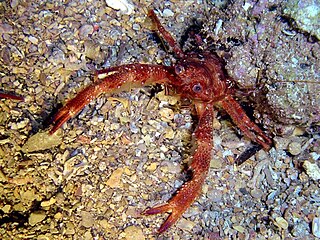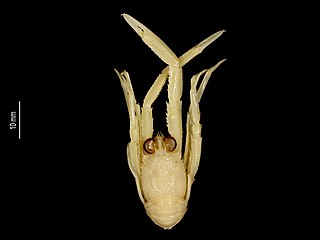
Squat lobsters are dorsoventrally flattened crustaceans with long tails held curled beneath the cephalothorax. They are found in the two superfamilies Galatheoidea and Chirostyloidea, which form part of the decapod infraorder Anomura, alongside groups including the hermit crabs and mole crabs. They are distributed worldwide in the oceans, and occur from near the surface to deep sea hydrothermal vents, with one species occupying caves above sea level. More than 900 species have been described, in around 60 genera. Some species form dense aggregations, either on the sea floor or in the water column, and a small number are commercially fished.

Carcinisation is a form of convergent evolution in which non-crab crustaceans evolve a crab-like body plan. The term was introduced into evolutionary biology by L. A. Borradaile, who described it as "the many attempts of Nature to evolve a crab".

Porcelain crabs are decapod crustaceans in the widespread family Porcellanidae, which superficially resemble true crabs. They have flattened bodies as an adaptation for living in rock crevices. They are delicate, readily losing limbs when attacked, and use their large claws for maintaining territories. They first appeared in the Tithonian age of the Late Jurassic epoch, 145–152 million years ago.

The Cape lobster, Homarinus capensis, is a species of small lobster that lives off the coast of South Africa, from Dassen Island to Haga Haga. Only a few dozen specimens are known, mostly regurgitated by reef-dwelling fish. It lives in rocky reefs, and is thought to lay large eggs that have a short larval phase, or that hatch directly as a juvenile. The species grows to a total length of 10 cm (3.9 in), and resembles a small European or American lobster; it was previously included in the same genus, Homarus, although it is not very closely related to those species, and is now considered to form a separate, monotypic genus – Homarinus. Its closest relatives are the genera Thymops and Thymopides.

Munidopsis serricornis is a species of squat lobster. It is widely distributed in the world's oceans, being found in the eastern Atlantic Ocean, the western Atlantic Ocean, and the Indo-Pacific. It grows up to a carapace length of 20 millimetres (0.8 in).

Galathea intermedia is a species of squat lobster in the family Galatheidae. It is found in the north-eastern Atlantic Ocean, as far north as Troms, Norway, south to Dakar and the Mediterranean Sea.

Galathea strigosa is a species of squat lobster in the family Galatheidae. It is found in the northeast Atlantic Ocean, from the Nordkapp to the Canary Islands, and in the Mediterranean Sea and Red Sea. It is edible, but not fished commercially. It is the largest squat lobster in the northeast Atlantic, reaching a length of 90 millimetres (3.5 in), or a carapace length of 53 mm (2.1 in), and is easily identified by the transverse blue stripes across the body.

Allogalathea elegans is a species of squat lobster that is sometimes kept in marine aquariums. Despite their common name, they are more closely related to hermit crabs than lobsters.
Anomoeomunida is a monotypic squat lobster genus in the family Munididae. The sole a species of is Anomoeomunida caribensis. It occurs in the western Atlantic.

Coralliogalathea is a genus of squat lobsters in the family Galatheidae. Initially thought to be monotypic, solely represented by Coralliogalathea humilis, recent analysis has split the genus into six, morphologically similar but genetically different species.

Plesionida is a genus of squat lobsters in the family Munididae. As of 2017, it contains the following species:

Raymunida is a genus of squat lobsters in the family Munididae, containing the following 11 species:

Munida rugosa, commonly known as the rugose squat lobster or plated lobster, is a species of decapod crustacean found in the north east Atlantic Ocean and the Mediterranean Sea.

Munididae is a family of squat lobsters, taxonomically separated from the family Galatheidae in 2010.

Lauriea siagiani, also known as the pink hairy squat lobster or the fairy crab, is a species of squat lobster in the family Galatheidae, genus Lauriea.
Munidopsis tafrii is a species of squat lobster first found in Taiwanese waters at depths greater than 3,000 metres (9,800 ft). It resembles M. ceratophthalma, however its carapace morphology distinguishes it from its cogenerate species.

Raymunida insulata is a species of squat lobster in the family Munididae from the Pacific and Indian oceans. The species can be distinguished by its morphology and its mitochondrial cytochrome c oxidase subunit I sequences.
Raymunida erythrina is a species of squat lobster in the family Munididae from the Pacific and Indian oceans. The species can be distinguished by its morphological characters and its mitochondrial cytochrome c oxidase subunit I sequences.

Raymunida confundens is a species of squat lobster in the family Munididae from the Pacific and Indian oceans. The species can be distinguished by its morphological characters and its mitochondrial cytochrome c oxidase subunit I sequences.
Munidopsis taiwanica, is a species of Munidopsis, a genus of squat lobster. Named after the type locality. Deepest known record for squat lobsters at 5491m in the Mariana Trench, and is the first confirmed species of squat lobster found in the mud volcano environment.













